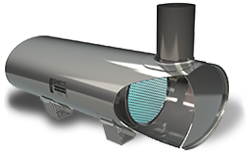Check our 3-Way Catalytic Converters designed especially for gasoline and gaseous LSI and SSI engines
Are LPG Emissions Regulated?
Emissions from LPG vehicles used indoors pose a health hazard to workers. As such, they are indirectly regulated by all occupational health and safety air quality standards. There are many regulatory authorities in different jurisdictions. Occupational Safety and Health Administration (OSHA) within the Department of Labor sets air quality standards at the federal level in the U.S. The corresponding regulatory authorities in Canada are located within provincial Ministries of Labour. Most air quality standards in North America are based on the guidelines established by the American Conference of Governmental Industrial Hygienists (ACGIH). The ACGIH Threshold Limit Values (TLV) for pollutants present in the LPG exhaust are listed in Table 5. The TLVs are time-weighted averages for an 8-hour workday.
| Substance | TLV (vppm) |
|---|---|
| Carbon Monoxide | 25 |
| Nitric Oxide | 25 |
| Nitrogen Dioxide | 3 |
| Butane | 800 |
| Sulfur Dioxide | 2 |
Most problems with indoor operation of LPG engines are related to carbon monoxide emissions. Sometimes also NOx emissions may be an issue. TLVs for carbon monoxide vary in different jurisdictions between 25 and 50 ppm. It is recommended that ambient concentrations of carbon monoxide be monitored on a regular basis wherever LPG engines are used.
There are several misconceptions regarding the CO monitoring of LPG vehicles operating indoors. The TLVs from Table 5 refer to the ambient air and not to the tailpipe emissions. By regulating the ambient air quality, LPG emissions are regulated only in an indirect manner. The ambient levels of CO are observed after exhaust gases leave the tailpipe and are mixed with air. They depend heavily on the ventilation rate in the building. The tailpipe emissions are not directly regulated, although they may be subject to recommendations. For example, the recommended maximum tailpipe CO level for LPG forklift trucks in Ontario is 1% (i.e. 10,000 ppm). The maximum ambient level of CO amounts to 35 ppm in the same jurisdiction. As the exact CO measuring procedures and, especially, the choice of sampling locations relative to the truck are often left to the discretion of OSHA inspectors, lots of area remains open for controversies. The inspectors, however, have upper hand in about 9 of 10 real life situations. To be on the safe side, the tailpipe emissions should be kept as low as possible by combining good engine maintenance with exhaust gas aftertreatment. Low tailpipe emissions allow also for lower ventilation rates (heating cost) and contribute to a healthier work environment for the equipment operators.
Nett Technologies’ 3-Way Catalytic Converters

Request A Quote
Photo Gallery

